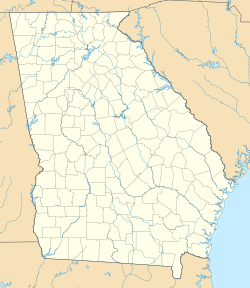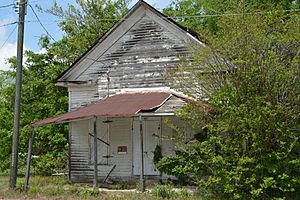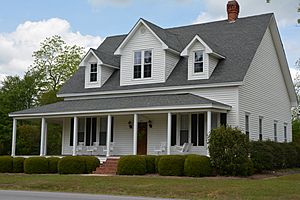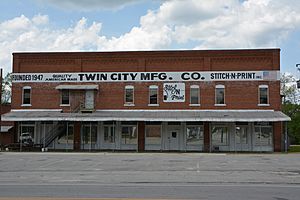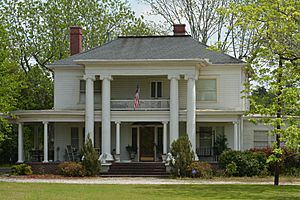Twin City Historic District facts for kids
Quick facts for kids |
|
|
Twin City Historic District
|
|
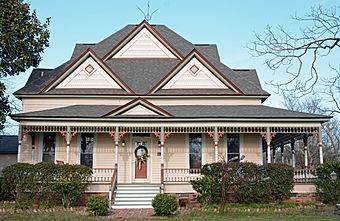
Davis-Proctor House, in the district
|
|
| Location | 6th, Railroad & 5th Aves., Maple & College Sts., Twin City, Georgia |
|---|---|
| Area | 255 acres (103 ha) |
| NRHP reference No. | 13001168 |
| Added to NRHP | February 8, 2014 |
The Twin City Historic District is a special area in Twin City, Georgia, located in Emanuel County, Georgia. It was added to the National Register of Historic Places in 2014. This means it's an important place with old buildings and history worth protecting.
Twin City itself is made up of two older towns, Summit and Graymont, which joined together. This historic district covers about 255 acres. It includes the main town center, shopping areas from both old towns, and neighborhoods where people lived.
The district covers an area from 6th Avenue on the west to Maple Street on the east. It also stretches from Railroad Avenue in the north to College Street and 5th Avenue in the south.
This special area has 135 buildings that help tell its history. These are called "contributing buildings." There's also one historic water tower. Some newer buildings, called "non-contributing," are also in the district.
Contents
Exploring Twin City's Historic Center
The center of Twin City is where many important buildings are located. These buildings are spread out and show different styles from the early 1900s to the mid-1950s.
Here are some of the cool buildings you can find:
- Old Jail and City Hall (around 1900): This brick building has cool arched doorways and windows. It sits right between the old towns of Summit and Graymont.
- Church of Christ (around 1900-1910): This church is made of brick and has a porch in the Craftsman style.
- Baptist Rest Primitive Baptist Church (1907): This church looks like a castle with its Gothic Revival style. It has tall, narrow windows and two square towers.
- Twin City Methodist Church (1927): This church has a classic Greek Revival look with columns and fancy trim.
- Adam Brinson Chapter DAR House (1934): This unique building is a real log cabin!
- Water Tower (1937): This tall structure was painted with "Twin City Home of the Bulldogs" in 2013.
- Boy Scout Hut (around 1945): World War II veterans built this one-story building. It has a special siding called board-and-batten.
- First Baptist Church (1949): This brick church has a grand entrance with columns, like an ancient temple.
- Emanuel County Institute Buildings (1954): There are three buildings from this school: an Agricultural Building with an arched entrance, a Main Building with a cross-shaped roof, and an Auditorium with a modern design and special windows.
Discovering Historic Summit
The old downtown area of Summit is in the northeast part of the district. Most of its historic shops and buildings were built between 1890 and 1945. You can find them mainly along North Railroad Avenue.
Some interesting spots in Summit include:
- 503 N. Railroad Avenue (around 1860s): This is likely the oldest building in Summit.
- O.A. Hall Store (early 1900s): A two-story building made of concrete blocks.
- Railroad Depot (1868): This train station was moved in 1954.
- Secab Building (around 1940): This building was once a warehouse.
- Commissary Building (around 1898): This building has a metal roof and a porch.
- Brick Commercial Buildings (1903, 1907): These old shops show off classic brickwork.
- Summit Bank (1904): A two-story brick building with Italian Renaissance style details.
Summit's Residential Charm
The neighborhoods in Summit are located north and south of Railroad Avenue. Many of the larger homes have unique twin gables and decorative wood shingles.
Here are some examples of the beautiful homes:
- 128 W. Broad Street: A charming cottage with special windows and a porch.
- Davis-Proctor House (1890): This house is so important it's listed separately on the National Register! It's a beautiful Folk Victorian style home with a wrap-around porch and decorative details.
- 115 W. Broad Street (1898): This cottage has elements of Neoclassical Revival style, like fancy columns on its porch.
- 202 N. Railroad Street (1908): Similar to 115 W. Broad Street, this Folk Victorian cottage has a full front porch with decorative posts.
- Sturgis House (1918): Another great example of a Folk Victorian house. It has cool wooden shingles in different patterns on its gables and a wrap-around porch.
Exploring Graymont's Commercial Hub
The main shopping area of Graymont is in the southwest part of the district. It's centered around Georgia State Route 192 and 5th Avenue.
Some of the historic buildings here include:
- Graymont Drugstore (1888): A one-story brick building with three storefronts.
- Livery Stable (1900): A two-story brick building where horses were kept.
- Bank of Graymont (1901): An important building for the town's finances.
- Citizens Trading Company (1900): A two-story brick building with four storefronts.
- Coleman Sanitarium and Hardware Store (1932): Rebuilt after a fire, this building served different purposes.
- Graymont Bank and Post Office Building (1901): A two-story brick building with fancy brickwork.
- Movie Theater (1918): Imagine watching movies here long ago!
- Theater Addition (1938): This part was originally a gas station. It has cool cast-iron posts.
- Hardware Store (1932): Another important shop in the town.
Graymont's Residential Areas
The neighborhoods in Graymont also have many historic homes. These areas show how people lived in the past.
Images for kids


